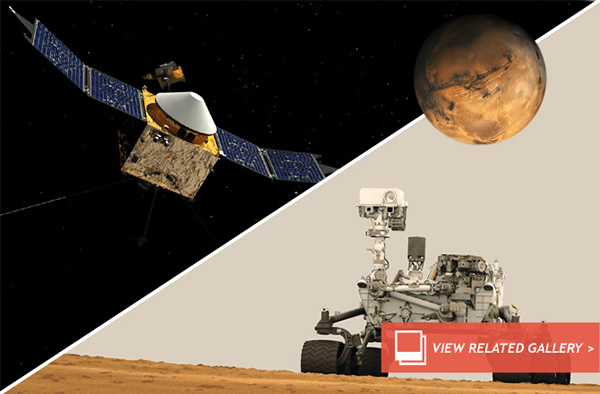MAVEN and Curiosity -- A Match Made On Mars
MAVEN and Curiosity -- A Match Made On Mars
One is a six-wheeled nuclear-powered rover, the other is an orbiting solar-powered climate satellite. The two robots couldn’t be more different — except they have one thing in common: Mars’ blighted atmosphere. And on Sept. 20, 2014, the pair will become the next interplanetary “power couple.”
NASA’s six-wheeled Curiosity rover, which began exploring Mars dirt on Aug. 6, 2012, will soon be joined by NASA’s Mars Atmosphere and Volatile EvolutioN (MAVEN) satellite that is due for launch at 1:28 p.m. EST today (Monday). Although at least 77 miles will separate them when MAVEN orbits overhead next year, both missions will find some common ground in their study of the thin Martian atmosphere.
Earlier this year, Curiosity used its instruments to analyze a sample of air from its location inside Gale Crater. The analysis of various atmospheric gases and their isotopes revealed that the Martian atmosphere likely underwent rapid changes some 4 billion years ago and that lighter isotopes in the atmosphere had been preferentially lost to space. Before that time, Mars was a very different place; it had a thick atmosphere and vast bodies of flowing liquid water — a habitable condition believed to be very conducive to basic lifeforms.
The assumption is that the loss of the Martian atmosphere was likely triggered around a time when there were many planetary impacts by comets and asteroids — a period known as the Late Heavy Bombardment. A massive impact may have caused critical damage to Mars’ internal dynamo, “switching off” its global magnetic field. The impact may have also blasted huge quantities of atmospheric gases into space. With no magnetic field to act as a force field against the sun’s continuous barrage of energetic particles, over time the remaining Martian atmosphere was literally stripped into space.
Another atmospheric loss mechanism assumes that due to Mars’ low mass, neutral particles in the atmosphere required less speed to escape the planet’s gravity. As gas particles collide and get kicked to higher velocities, they get booted into space, never to return. These atmospheric loss processes are linked with Mars water history; as the atmosphere became thinner, water was frozen into the crust and also lost to space.
So, taking a lead from Curiosity’s ground level isotopic analysis, MAVEN will swoop in and begin a planet-wide survey of Mars for a one-year primary mission (although mission managers hope MAVEN will continue to operate for many years after that), piecing together the complex puzzle of the Martian atmosphere from orbit. By taking isotope samples and understanding the interaction with the sun’s solar wind and magnetic field, a history of atmospheric loss can be examined, hopefully creating a picture of what has blighted Mars for the last few billions of years.
MAVEN will also form a very intimate link with Curiosity. Carrying a sophisticated radio transmitter, the orbiter can act as a communications relay between Earth and the Martian surface. Currently, that job is being carried out by NASA’s two veteran satellites, Mars Odyssey and Mars Reconnaissance Orbiter — missions that arrived at Mars in 2001 and 2006 respectively. MAVEN will provide a critical link to rovers Curiosity and Opportunity should the older orbiters fail.
But like all good robotic pairings, the partnership wont be embedded in our psyche until one robot photographs the other. But in the case of MAVEN, it doesn’t have the photography capabilities of its sister orbiters, so don’t expect any orbital beauty shots of Curiosity from MAVEN looking down. It will actually be Curiosity that will have the photo op, looking up.
As the video below shows, there will be points in MAVEN’s mission where its orbit will fly straight over Gale Crater. Should the lighting be just right, at Mars dusk, Curiosity should be able to image the orbiter as it passes overhead.
So as we look forward to the launch of MAVEN from Cape Canaveral, Fla., later today, remember that it will soon be joining three other orbiters and two active rovers that are all working to assemble the puzzle of he red planet’s history and its potential for habitability — from the cores of rocks to the uppermost regions of the atmosphere.(Nov 18, 2013 03:35 AM ET // by Ian O'Neill)












